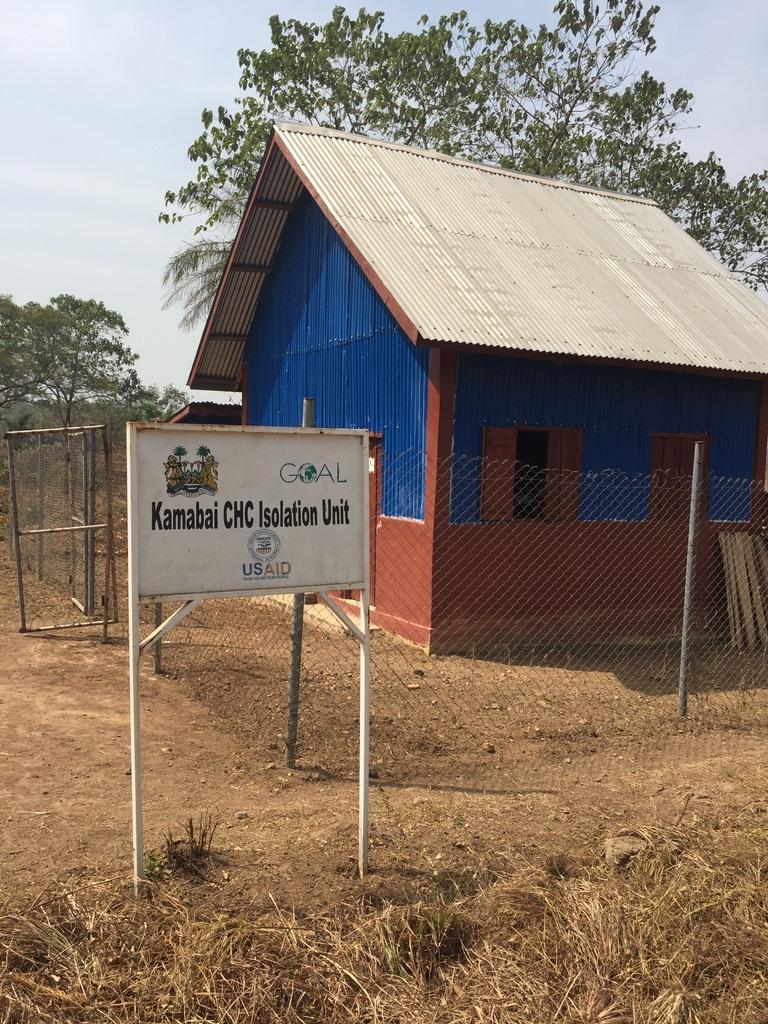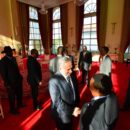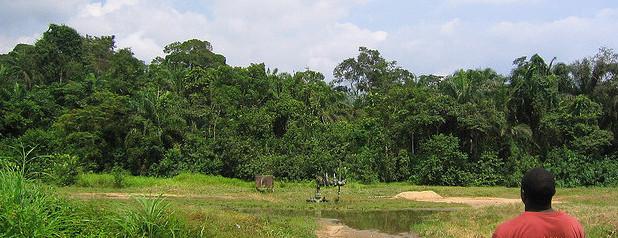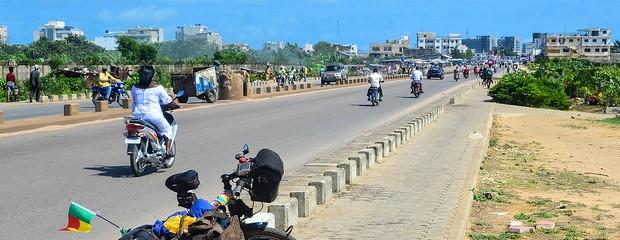Preparing for Covid-19 in Africa

Debating Ideas is a new section that aims to reflect the values and editorial ethos of the African Arguments book series, publishing engaged, often radical, scholarship, original and activist writing from within the African continent and beyond. It will offer debates and engagements, contexts and controversies, and reviews and responses flowing from the African Arguments books.

Local makeshift Ebola holding ‘shed’ outside the village health centre in Gondama, Kamajei chiefdom (Credit: Paul Richards)
Covid-19 is a respiratory disease caused by a new Corona virus, SARS CoV-2. It has now become pandemic. The illness has been slow to reach Africa, but there is reason to suspect its eventual progression will be broadly similar to China and the rest of the world.
Although death rates are much lower than with Ebola Virus Disease the greater capacity of Covid-19 to spread and infect substantial numbers of people (potentially up to 60–80 per cent of the population) means that overall fatalities will be greater than for Ebola.
As with any epidemic things start slowly and then accelerate at a dizzying rate. The early phase, when there are few cases, is the time for preparation. But what should African countries be doing?
Covid-19 affects all age groups but is more serious for older people and people with underlying medical conditions.
The greater youthfulness of the population in Africa, when compared to Europe or China, might indicate lower death rates in Africa. But this will be affected by co-morbidities. People with compromised immune systems seem to be at greater risk, so infection is likely to be dangerous for people with HIV/AIDS. High levels of endemic malaria might also be a serious complication.
Thus, African countries should not expect a ‘mild’ version of the disease. Planning should aim to slow down the spread of the disease (to protect limited health resources, so that hospitals are not rapidly overwhelmed) and to protect vulnerable groups through adopting special measures such as cutting off contacts with potentially infectious visitors (see below).
Many African countries have already acted to halt importation of cases, by measures such as ending flights from high-risk regions.
They now need to follow China, South Korea and other countries in identifying cases and tracing contacts. Countries familiar with Ebola know how to do this. But case finding will be much harder than for Ebola since Covid-19 cases shed virus before patients have developed symptoms, and thus before they know they are ill.
Capacity to test cases is important, but raises logistic challenges of kit supply, laboratory capacity and turn-round times. False positives and false negatives are also problems. Tests do not necessarily distinguish between persons with active disease and those with molecular fragments of the virus in their system.
It is thought unlikely that patients having survived Covid-19 will get sick a second time with the disease, at least in the short term, but China has experienced problems with discharge of patients from hospitals too quickly, and in some cases these people have gone on to infect patients after they thought they were fully recovered.
At present, tests to identify those who have had the disease, and thus are safe to go back to work, are not yet available.
These tests can be expected shortly and will be helpful in identifying immune survivors. As with Ebola, survivors are very helpful in addressing bottlenecks in care. The good news is that there will be many more survivors than with Ebola – most of the infected population in fact. But African countries will have to join a queue for antibody tests when available.
African health systems are generally poorly equipped to cope with a huge spike in respiratory cases. Some immediate strengthening will be needed to supply necessary items – electricity, oxygen and breathing apparatus. But nurses have to be trained to use these devices. In the UK training is currently as big a bottleneck as supply of ventilators.
As in other parts of the world, but more so, special steps have to be taken to slow the spread of the disease, to isolate the most vulnerable, and to protect entire communities, especially in regions where hospital care is remote or unavailable.
Fortunately, much can be done, and experience of Ebola helps.
One of the big lessons of Ebola was what it taught about the importance of helping local populations to adapt their behaviour through a good understanding of infection dynamics. Danny Cohen called this ‘helping communities to think like epidemiologists’, to which I added the proviso that epidemiologists needed also to learn to think like communities (see ‘What Might Africa Teach the World? Covid-19 and Ebola Virus Disease Compared’).
That way better adaptive thinking will be encouraged, and some of the more futile or nonsensical ideas can be quickly weeded out.
Perhaps a useful approach for behavioural adaptation to Covid-19 is to make use of the social science research method known as ‘proxemics’. First proposed by the anthropologist Edward T. Hall in the 1960s it involves paying close attention to the presentation of the body in social interaction as an important aspect of non-verbal communication.
World-wide, epidemiologists have used the jargon term ‘social distancing’ without really being able to explain clearly what this implies. Some people think it means physical distancing, others that it means cutting down social contacts. In fact, both are implied, but the term itself says little about how it is done.
Ebola-affected villagers in Mende-speaking districts of Sierra Leone during Ebola in 2014–15 showed the way, by calling the disease attacking them bonda wote (‘family turn around’, or ‘family stand back’). They quickly understood that to reduce risks of Ebola infection they needed to make proxemic adjustments to group activity, and family life especially.
Covid-19 and Ebola are both diseases that transmit when humans form crowds. The crowd does not need to be large. A family gathering will be sufficient. Evidence shows that much Covid-19 transmission takes place in family settings. The German chancellor, Angela Merkel, has fully grasped the implications of the disease. She has ordered Germans citizens not to gather in groups of more than two persons (three’s a crowd).
But crowding is not a single measurable quantity. It needs to be thought through in terms of how and why it happens.
One of the merits of proxemics is that it recognises that crowd or group dynamics vary culturally. Groups use living space differently; they have different preferences for how close they stand or sit apart, for example. Queues are managed differently in different places – sometime people form a line, in other instances they queue by taking a numbered ticket. There is no single rule for forming a queue so that people are safely spaced.
This requires African countries to re-think many everyday but culturally specific scenarios of social contact, if Covid-19 is to be held back.
A first response is to play safe. How many activities are not essential? If it is not essential, then cancel it. Going to a bar, even going to school or church, can be suspended for a time until the infection peak has passed. Doing so will reduce the death rate among vulnerable people and the pressure on fragile health systems.
But not everything can be cancelled, or the damage from cancellation will rapidly approach and exceed the damage caused by the epidemic.
Families in Africa (as we discovered with Ebola) will insist on caring for their members, whatever the cost; thus, ways have to be found to care safely, for example the single-carer system (see below).
People will also have to secure their livelihoods. With modern supply chains and home delivery, and governments rich enough to guarantee incomes for a period, European countries can ask people to stay at home for considerable periods of time, maybe up to the 12 weeks or so that modellers think will be needed to turn the epidemic. But in Africa, no work and no markets mean potential starvation for many within a matter of days.
This is where proxemic thinking may prove useful. It encourages us to re-imagine the fields of social interaction in which problems may be encountered in order to find ways of reorganising internal space to allow essential functions to take place more safely.
This has already begun to happen in Europe. My local supermarket now has tills screened by plastic boarding to keep check-out staff and customers from coming face to face. Queuing customers are regulated by lines of sticky red-and-white tape pasted on the floor, to indicate safe standing distances.
We saw the same kind of proxemic improvisation with tape and hastily erected stick fences surrounding Ebola-quarantined houses in West Africa in 2014–15.
But with Ebola we had a good idea where the virus was located. With Covid-19 there is much less clarity. To emphasise, Covid-19 can be spread by people who have no idea (yet) that they are sick, and many more people will be carriers as the epidemic advances. So, the degree of separation, and the improvisation to achieve it, will have to be more extensive.
Transport is obviously a major focus of concern. African transport is largely by bus, or motorcycle taxi, and over-crowded, often to an extreme degree. Authorities are already thinking about this problem and issuing instructions about control of over-crowding. But a bus with even a regulation number of passengers is likely to be a Covid-19 infection factory.
In Europe, trains are running three-quarters empty, after appeals to non-essential workers to stay at home. But in Africa a bus does not move until every seat is occupied. More thought will be needed – either a scheme to subsidise the bus operators, or to involve them in developing innovative internal passenger separation solutions of their own devising, maybe along the lines of the European improvised supermarket screens.
The motorcycle taxi presents another set of problems. These are a very important means of transportation in Africa, and particularly so in rural districts where four-wheeled vehicles cannot always reach.
Bike taxis were often used in the 2014–15 Ebola epidemic in Upper West Africa to extract suspected cases and ferry test samples and results in remote areas. Halting bike taxi transport during an epidemic of Covid-19 may not be desirable (they are a rural lifeline), or even possible (who will control them on village roads where the police rarely venture?)
So, the focus shifts to what the riders, and passengers, can do to protect themselves, and others, while on the move.
Riders became very conscious of the need to understand and avoid infection risks during the West African Ebola epidemic. At times, they improvised their own Personal Protective Equipment from reversed rain-coats, goggles and plastic bags.
This inventiveness should be encouraged. To this end, the riders’ own organizations (their trade associations and unions) should be brought into infection control planning at an early stage. Offering infection control training, PPE and sanitation materials through bike rider unions might be an important contribution to keeping some essential supplies moving in rural districts at the peak of the epidemic.
Markets are also another major potential infection source. The initial spillover of SARS CoV-2, the virus causing Covid-19, is thought to have occurred via bush meat sales in a wet produce market in Wuhan in China (see also Theodore Trefon; ‘COVID-19 and the Culture of Eating Wild Animals in Central Africa’). Deciding to close markets is a major step because they are essential to daily survival. If they remain open then new internal layouts may be needed to control and regulate the flow of people through them.
In country districts, this might involve temporary relocation of the entire market to a more convenient location (maybe a village football pitch) so that stalls (which are often mainly stick shelters) can be spaced more generously, with perhaps some internal system of guide rails to channel customers through at safe intervals. It might also be possible to work with market authorities to reduce the range of goods sold (people can perhaps manage without buying second-hand clothes for a period, but not without essential foods).
Urban markets will be less easy temporarily to re-design. Here the emphasis should be on reducing crowding and good hand and surface hygiene. Market officials may need gates to control numbers of people entering, and loud hailers to encourage purchases to be made swiftly (haggling may have to be suspended).
All these measures will be a prelude to more draconian action if and when case numbers reach a critical point. The government of India has now ordered the entire country to enter a period of lockdown.
Perhaps the biggest challenge to infection control is within the household. This was a major site of Ebola infection, and some aspects of Ebola household infection control techniques can be transferred to Covid-19.
Under Ebola a system was devised of having households designate a single carer, who attends to the needs of the sick person, while the other household members work to meet the needs of the single carer. People understood this quickly, and it appears to have worked well. It needs to be widely re-purposed for Covid-19.
Isolating the patient or a person suspected of being in close contact with a case of Covid-19 can also be attempted using outdoor temporary accommodation.
In Europe authorities have talked rather glibly about isolating an infected person in their own bedroom, and even of allocating them a separate bathroom, suggesting that politicians live at a rather different level from those they rule. What are the homeless to do?
But in warm climates there are more opportunities to develop temporary solutions. A day-time shelter from the sun, readily constructed from thatch and sticks, is a common feature of much African housing. Sierra Leoneans, for example, commonly have open sided sheds (bafa) in their compounds for cooking or relaxation.
A hastily erected but well-located additional shed can safely accommodate a Covid-19 case in a protected zone, with family members restricted to other nearby locations such as verandas or kitchens, but still within talking distance. The key to this operation is to recognise the importance of reducing social isolation while increasing physical distancing.
The same approach can be taken to the sequestration of healthy but potentially vulnerable people.

Isolation ward, Health centre in Sierra Leone – Credit: Paul Richards
Crowded slums and refugee camps, however, will probably require different approaches. Here an answer might be a hastily-erected isolation and triage facility, modelled along the lines of the Ebola Community Care Centres used in Sierra Leone in 2014–15.[1]
It is also important not to underestimate the importance of informal and parallel forms of public authority in such areas.
During Ebola in Liberia agencies were afraid to enter the notorious West Point ‘ghetto’ of Monrovia, home to many former combatants. Local residents led by bike taxi riders and commercial sex workers organised their own effective response to infection. As a result, the locality did not become the expected time-bomb for Ebola infection. Already, there are reports of something similar in Brazil – where gangs in favelashave started to organise quarantine and lock-down in the absence of government response.[2]
Protective sequestration of entire communities might also be considered. Under the threat of Ebola a number of rural communities in Sierra Leone successfully kept out cases of the disease through vigilant community control of local borders. Isolated Maori groups in New Zealand with little access to doctors or hospitals are reported to have begun taking the same approach to Covid-19.[3] The use of such civil defence cordons might prove very helpful in holding back the disease from more isolated rural districts of Africa.
In conclusion, fewer cases means fewer deaths, and more time to find long-term solutions such as vaccines and medication. In the developed world much emphasis is being given to psychological approaches to behaviour modification, to reduce threat of Covid-19. Proxemics might be a more useful guide to relevant preparation in Africa.
Footnotes:
[1]Mokuwa, E.Y., Maat, H. (2020) ‘Rural populations exposed to Ebola Virus Disease respond positively to localised case handling: evidence from Sierra Leone’, PLoS Negl Trop Dis 14(1): e0007666. Available at: https://doi.org/10.1371/journal.pntd.0007666.
[2]Baretto Briso, C. and Phillips, T. (2020) ‘Brazil gangs impose strict curfew to slow down coronavirus spread’, The Guardian, 25 March 2020.
[3]Graham-McLay, C. (2020) ‘New Zealand Maori tribes set up checkpoints to avoid “catastrophic” coronavirus deaths’, The Guardian, 23 March 2020.
A French version of this article, translated by Vincent Hirribarren, was simultaneously published on the Africa4 blog of Libération. This is available here: http://libeafrica4.blogs.liberation.fr/2020/03/30/se-preparer-pour-le-covid-19-en-afrique/.
Africa4 and African Arguments – Debating Ideas are collaborating in order to overcome linguistic barriers between academic communities.






